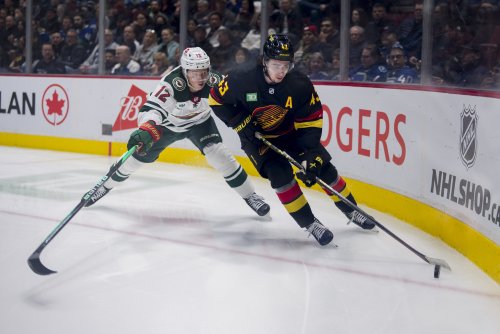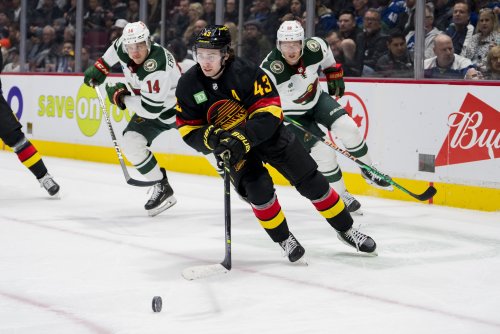
The State of Hockey’s long nightmare may soon be over.
In less than two weeks, Kirill Kaprizov’s contract with CSKA Moscow will expire. Assuming nothing goes wrong, the Minnesota Wild will finally sign the 23-year-old star who has led the KHL in goals in each of the past two seasons.
If Kaprizov indeed signs and makes his NHL debut in the 2020-21 season, it’ll be one of the most anticipated debuts in recent Minnesota sports history. Almost immediately after he was drafted, Kaprizov established himself as an elite NHL prospect, one they haven't had since (at least) Mikael Granlund. And the five-year wait for him to arrive has been agonizing -- almost unprecedented in recent Minnesota sports history.
The Wolves were in a will-they-or-won’t they relationship with Spanish star Ricky Rubio, but he was in a Wolves uniform two seasons after he was drafted. The Wild waited for Granlund to come from Finland, but he was in Minnesota after just two seasons. Even with baseball’s notoriously lengthy minor-league process, Twins fans got to see Byron Buxton at Target Field three years after he was drafted.
The only comparable wait for a hyped prospect in recent memory was Miguel Sano (signed in 2009, debuted in 2015), and that was mostly because he was signed at age 16.
But beyond the hype, what’s the common thread among these four former hotshot prospects? All experienced growing pains upon coming to Minnesota.
Rubio’s ball distribution was as advertised, but it took years to improve his lackluster shot. Granlund struggled on the fourth line in his debut, and didn’t break out until his fourth season with the Wild. Buxton has had incredible stretches interrupted by period struggles and even more frequent injuries. Even Sano, who had the strongest debut, has alternated good and bad seasons and never has played 120 games.
None of this history will tamp down expectations for Kaprizov -- and frankly, it probably shouldn’t. Kaprizov has experienced nothing but success at every level he’s played in. His points-per-game in the KHL has climbed every year from his age-18 season (0.51) until his age-22 year (1.09). He captured a Gagarin Cup with CSKA. He won Olympic Gold for Russia in 2018, where he tied for the tournament lead in goals (five) and finished second in points (nine). He was named Best Forward in the 2017 World Juniors, racking up nine goals and 12 points in seven games.
Even the biggest concern with most European prospects, whether they can adapt to the smaller North American ice sheet, feels like it doesn’t apply to Kaprizov, who tends to get his opportunities (and goals) either on the rush or working around the net. That style will play in the NHL much better than someone who tends to create chances in the spacious perimeters in Europe.
But even if we don’t have much reason to be pessimistic with our expectations, we should ask: where should our expectations be?
Let’s take a look at how six KHL stars have done making this transition. We’ll look at their points-per-game totals in their last KHL season, then see what they did in the following year in the NHL.
| Player | Age | Year | PPG, final KHL year | PPG, first NHL year | Difference |
| Panarin, Artemi | 24 | 2015-16 | 1.15 | 0.96 | -17% |
| Dadonov, Evgenii | 28 | 2017-18 | 1.24 | 0.88 | -29% |
| Kuznetsov, Evgeny | 22 | 2014-15 | 0.68 | 0.46 | -32% |
| Tarasenko, Vladimir | 22 | 2013-14 | 1.03 | 0.67 | -35% |
| Radulov, Alexander | 30 | 2016-17 | 1.23 | 0.71 | -42% |
| Gusev, Nikita | 28 | 2019-20 | 1.32 | 0.67 | -49% |
| Kaprizov, Kirill | 23 | 2020-21 | 1.09 | ??? | ??? |
It’s perhaps an imperfect science, with factors like age and general team situation gumming up the works. But as a group, there was a 31 percent dropoff in point-per-game total. This would leave Kaprizov at 0.75 points per game, or 62 points over a full 82-game season.
In these individual cases, we can see best and worst-case scenarios. Artemi Panarin clearly fared the best among the bunch, capturing a Calder Trophy for his rookie performance. And looking at his situation, he was placed in perhaps the best position to succeed skating alongside a bona fide superstar in Patrick Kane.
And we see the flip side in Nikita Gusev, who saw his points-per-game cut in half upon crossing the ocean. Gusev is a legitimate offensive talent, but found himself languishing on a third line on a bottom-10 offensive team in New Jersey. And all due respect to frequent linemates Pavel Zacha or Blake Coleman, but neither was going to be the Kane to Gusev’s Panarin.
The most intriguing comparisons are the players who made their debuts at the youngest age: Tarasenko and Kuznetsov. Both were 22 when they made their full-season NHL debuts, one year younger than Kaprizov will be if he arrives next season. They both put up respectable numbers in limited minutes, with Tarasenko putting up 42 points in 66 games, and Kuznetsov tallying 37 points in 80.
But their age-23 seasons are when they took off. Tarasenko scored 37 goals en route to a 73-point season, while Kuznetsov had a 20-goal, 77-point season himself. Obviously, those seasons are a tall order for Kaprizov to fulfill in his rookie season, but his stats tracked pretty well with both of those players in the KHL.
| KHL Points/Game | Tarasenko | Kuznetsov | Kaprizov |
| Age-18 Season | 0.45 | 0.73 | 0.51 |
| Age-19 Season | 0.97 | 0.83 | 0.86 |
| Age-20 Season | 1.03 | 0.86 | 0.87 |
| Age-21 Season | N/A | 0.67 | 0.89 |
Even though the possibility exists that Kaprizov could tear the doors off on Day 1, it probably is important to keep expectations in check. Somewhere between a 50-60 point pace should be seen as a successful transition year, with a floor somewhere in the 40-point range. Anything above that is house money.
Of course, Minnesota can look at recent history to maximize Kaprizov’s odds at a Calder Trophy push.
Of the six players we profiled, the best transition years belonged to Panarin and Dadonov. We covered Panarin’s connection to Kane, but overlooked what went right for Dadonov in Florida. The stories are similar. Dadonov was attached to the hip of the dynamic Sasha Barkov, and the two offensive players propelled them to new heights.
A long-running concern with Kaprizov’s eventual arrival was that there was no Kane or Barkov in place to bring Kaprizov along. That doesn’t appear to be the case anymore with Kevin Fiala’s breakout season.
While it is tempting to move towards a future where Kaprizov and Fiala are running their own lines, there’s no use shying away from a winning formula. Minnesota should try to build chemistry between their budding stars.
On paper, this is a pairing that should compliment each other. Fiala was at his best when he was allowed to create off the rush, or create havoc around the offensive zone with Zach Parise handling the net-front duties. And assuming Kaprizov’s motor and net-front game come with him from Russia, Kaprizov is a younger, faster, more creative version of Parise.
Both players will have questions. Can Kaprizov live up to the hype? Can Fiala build off his fantastic year? The only thing for certain is that these two will create the most buzz the State of Hockey has had since the Wild signed Parise and Ryan Suter in 2012.
You can expect to be entertained. For a franchise defined by stifling defense and with little to show for it, it's a welcome change.
Think you could write a story like this? Hockey Wilderness wants you to develop your voice, find an audience, and we'll pay you to do it. Just fill out this form.








Recommended Comments
Join the conversation
You can post now and register later. If you have an account, sign in now to post with your account.
Note: Your post will require moderator approval before it will be visible.